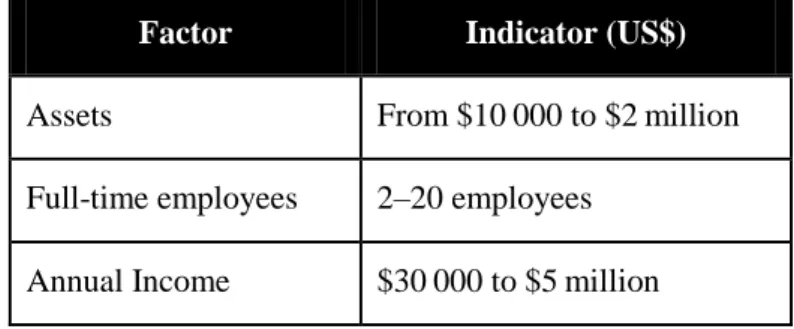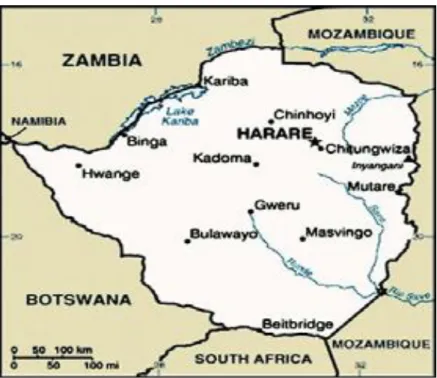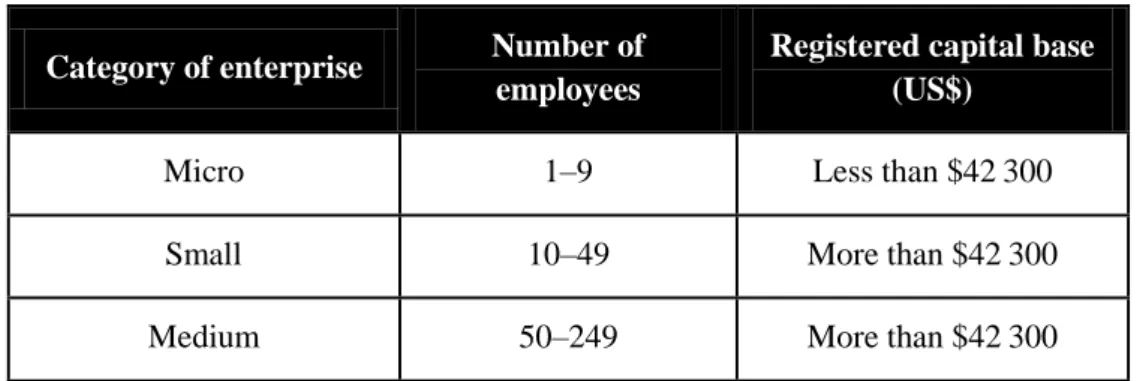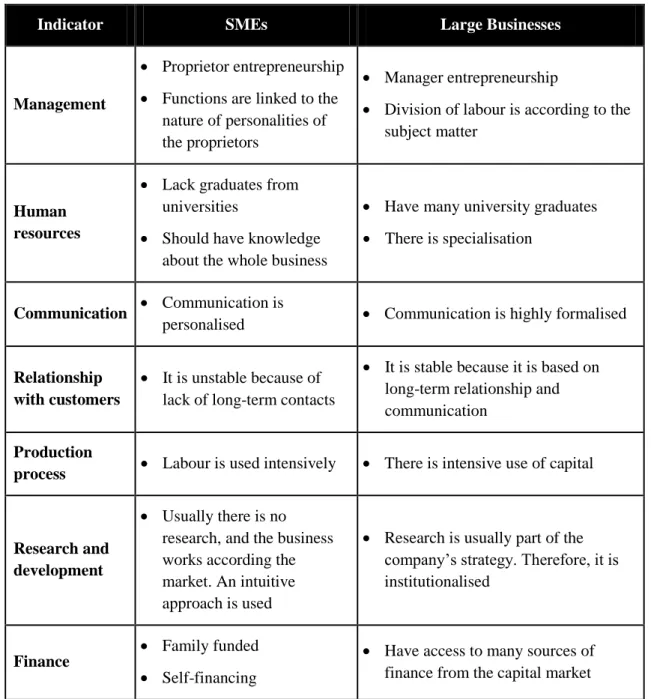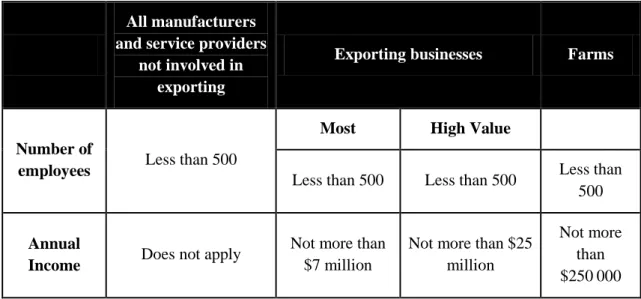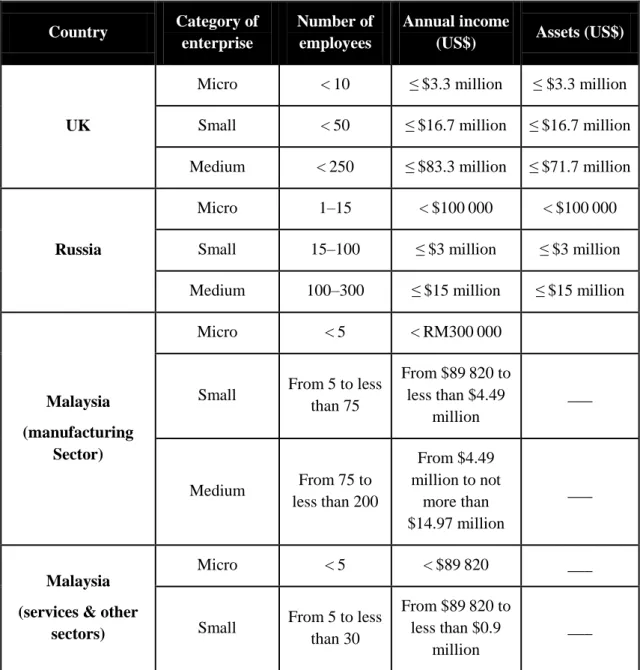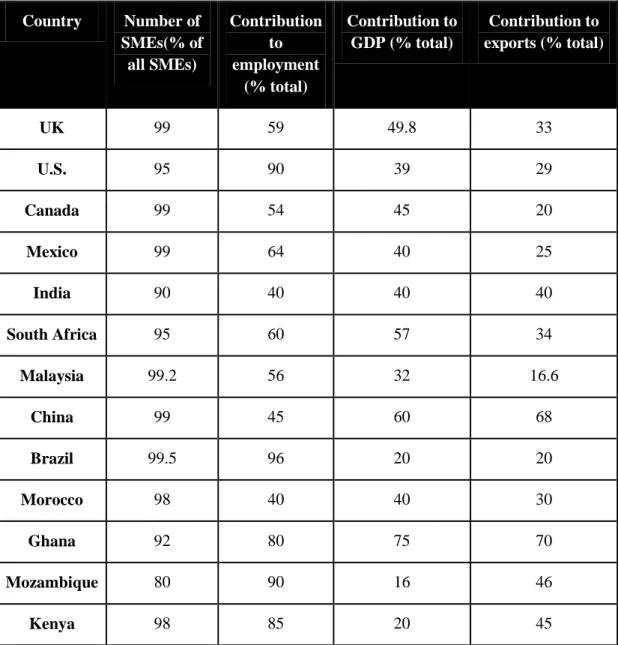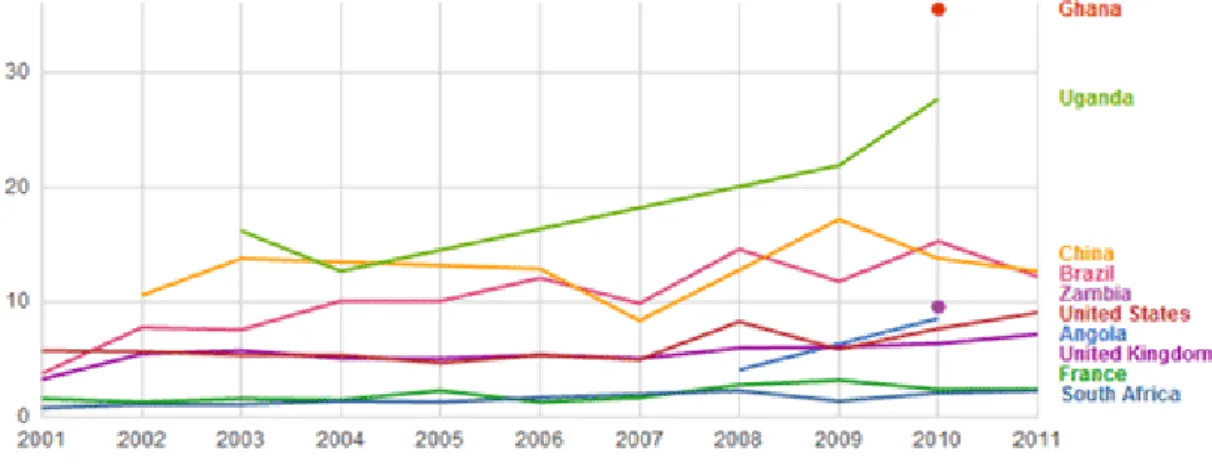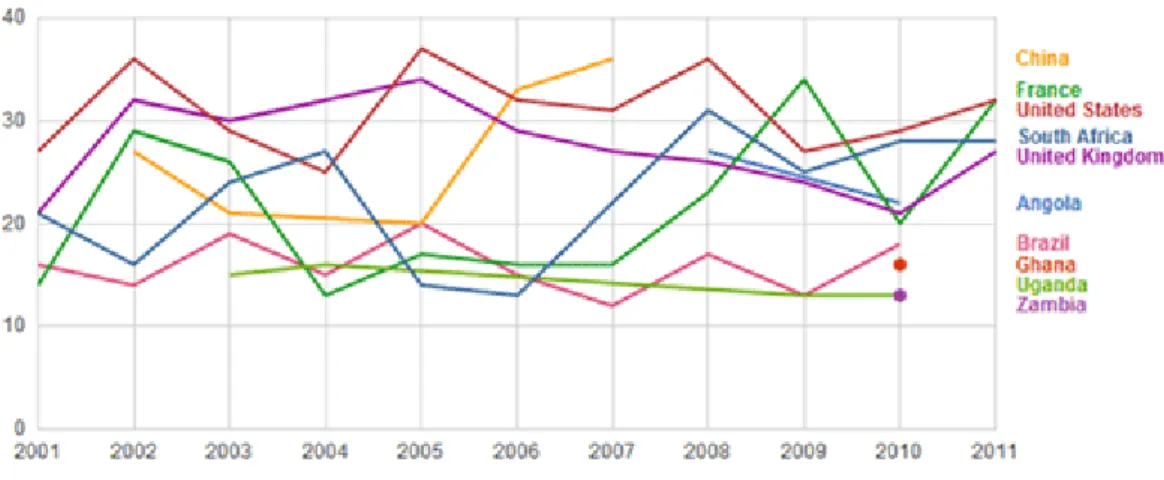From the same university I had access to journals, textbooks and other resources that were very crucial in writing this dissertation. I would also like to appreciate the role played by Olinda Mombeyarara in the preparation and writing of this dissertation. The research was conducted with a view to developing a policy and strategy framework for promoting SME development in Harare, Zimbabwe.
SMEs, officials from the Ministry of Small and Medium Enterprises and Cooperative Development (MSMECD), officials from the Small and Medium Enterprise Development Corporation (SMEDCO) and academics from three state universities in Harare constituted the population studied. Purposive sampling was used to select officials from the MSMECD and SMEDCO, as well as key informants from three state universities in Harare. Questionnaires were administered to SMEs, while in-depth interviews were conducted with officials of SMEDCO and MSMECD, as well as key informants from the three state universities.
Content analysis was used to analyze the qualitative data from the in-depth interviews. Furthermore, the study proposes a policy and strategy framework for promoting SME development in Harare, Zimbabwe.
LIST OF ACRONYMS AND ABBREVIATIONS
NATURE AND SCOPE OF THE STUDY
- INTRODUCTION
- BACKGROUND OF THE STUDY
- MOTIVATION FOR THE STUDY
- RESEARCH PROBLEM
- RESEARCH AIM AND OBJECTIVES
- RESEARCH QUESTIONS
- Research philosophy
- Research design
- Research approach
- Study context and site
- Population and sampling
- Data collection
- Data analysis
- LIMITATIONS OF THE STUDY
- ETHICAL CONSIDERATIONS
- CONCLUSION
Such evaluation leads to the improvement of existing policies and strategies, or Based on the evaluation results, the researcher has developed a policy and strategy framework to promote SME development in Harare, Zimbabwe. The target population in this study was composed of SMEs in various sectors of the economy in Harare, Zimbabwe.
Permission was sought from the senior management of MSMECD and the Harare Chamber of SMEs. These countries are the United States (US), United Kingdom (UK), Russia, India, Malaysia and South Africa. Also included in the chapter is a discussion of the challenges faced by Zimbabwean SMEs and the government policies and strategies that have been implemented to address the obstacles.
An assessment of the success of these government policies and strategies in addressing the challenges is also provided. The expected results of the right policies and strategies are also described in this chapter.
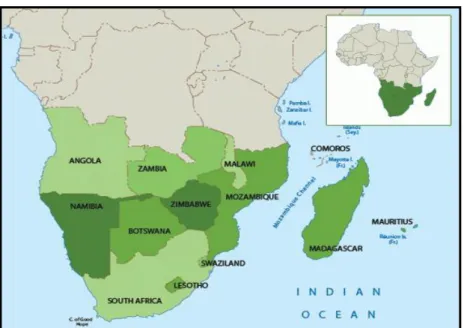
SMEs IN THE GLOBAL WORLD
- INTRODUCTION
- DEFINITION OF THE CONCEPT OF SMEs
- SMEs as defined by international organisations
- SME definitions in selected countries
- SMEs IN THE GLOBAL CONTEXT
- SMEs in developed economies
- SMEs in emerging economies
- SMEs in the developing countries of Africa
- BUSINESS OWNERSHIP RATE AND GROWTH .1 Business ownership rate .1 Business ownership rate
- SME growth expectations
- CHALLENGES CONFRONTED BY SMEs IN THE GLOBAL WORLD
- Financial challenges
- Global competition
- Difficulty in accessing information about markets and government assistance assistance
- Lack of managerial capabilities and skilled workforce
- Macro-environment
- SME POLICIES AND STRATEGIES IN SELECTED COUNTRIES
- United States of America (U.S.)
- Russia
- India
- Malaysia
- CONCLUSION
Each nation has its own definition of SMEs (Inyang, 2013). The term 'SME' usually refers to micro, small and medium enterprises (CBT, 2010; . United Republic of Tanzania Ministry of Trade and Industry, 2002; Zimbabwe Small Enterprise Development Corporation Amendment Act, 2011; WBG, 2012). The classification of SMEs into small and medium enterprises by the World Bank is based on the number of full-time workers, annual sales and/or the total value of assets (Kushnir et al., 2010). The World Bank (Table 1) describes small enterprises as those formal sector businesses with between 10 and 50 employees, and total assets and/or total annual sales of up to US$3 million, while medium enterprises between 50 and 300 workers and a balance sheet total or annual have sales total ranging from US$3 million to US$15 million (CBT, 2010; Kushnir et al., 2010; International Monetary Fund (IMF), 2013). This suggests that SMEs in the developed world lag behind SMEs in emerging economies in internationalizing their businesses.
Malaysian SMEs account for 32% of the country's GDP (Gunto & Alias, 2013), and export products to the US, the EU, Japan, Hong Kong, the People's Republic of China and several other countries, indicating that the Malaysian economy is making rely on production for export (Senik et al., 2010). In the Democratic Republic of the Congo (DRC), 71% of the population lives in extreme poverty, and the quality and effectiveness of education is low, with only 18% of pupils progressing to secondary schools (AfDB & African Development Fund (ADF) , 2013). Less than 26 % of the population in the DRC has access to basic health, and the health facilities are poor (AEO, 2005).
Entrepreneurs in Zambia, Uganda and Ghana have the lowest expectations for SME growth, while entrepreneurs in the US, Britain, France, China and South Africa have higher expectations. Developed economies are characterized by large and sustainable SMEs (Serrasqueiro et al., 2008, cited in Zarook et al., 2013), for example SMEs in the US, the UK and France. Based on a literature review, Avecedo and Tan (2010) identify 19 rigorous strategy evaluation studies, 10 from high-income countries (including the US, UK, Republic of Ireland and Northern Ireland, Australia, New Zealand, Belgium and Japan) and nine from developing countries (including Chile, Mexico, Argentina, Brazil, Bangladesh and Turkey).
It is a requirement that SME legislation is in the best interest of SMEs. The government provides 60% of the guarantee and the scheme is administered by five accredited financial institutions involved in the Project Merlin agreement (UKDBIS, 2012). As a result of the government support, the MSME sector has grown, leading to the provision of employment to the Indian population (Jahanshahi et al., 2011).
The participation of MSMEs in the tendering process was one of the key issues addressed in the Act (IMMSME. In the Office of the Development Commissioner participated in nine international fairs in which 131 MSMEs participated (IMMSME, 2014). Indian Institute of Packaging is also involved in the running of the training programs for MSME exporters (IMMSME b).
Such universities include UKZN (UKZN, 2014), the University of the Witwatersrand (Wits Business School, n.d.), the University of Cape Town (UK Center for Innovation and Entrepreneurship, 2009), the University of Johannesburg (University of Johannesburg, 2014) and the University of Fort Hare (Fort Hare Center for Entrepreneurship, n.d.). Access to local and international markets is one of the challenges facing SMEs in South Africa (Nieman & Nieuwenhuizen, 2009). Information dissemination workshops and seminars are held by the government to ensure that MSMEs are informed about the changes in the local and international markets.
The researcher draws knowledge from the policies and strategies of other countries in designing the policy framework and strategies for SME development in Zimbabwe.

SMEs IN THE ZIMBABWEAN CONTEXT
- INTRODUCTION
- ZIMBABWEAN DEFINITION OF SMEs
- AN OVERVIEW OF SMES IN ZIMBAWE
- The location of Zimbabwean SMEs
- SME contribution to GDP and economic growth
- SMEs’ contribution to poverty alleviation
- SMEs: An opportunity for women and youth to participate in the economy
- SMEs’ contribution to competition
- THE DEVELOPMENT OF SMES IN ZIMBABWE
- SME CHALLENGES IN ZIMBABWE
- Financial challenges
- Administrative and management challenges
- Lack of adequate infrastructure
- Domestic and international competition
- Lack of information about markets and government support
- The legal and regulatory environment
- INSTITUTIONS, POLICIES AND STRATEGIES TO ADDRESS SME CHALLENGES CHALLENGES
- Institutions to promote SME development
- Government partnership with other countries and non-governmental organisations organisations
- OTHER POLICIES AND STRATEGIES
- The Medium-Term Plan (2011–2015)
- Promotion of access to local and international markets
- Participation of SMEs in the public procurement process
- The role of higher education institutions
Most companies (71%) have been in business for five years or less, while only 8% are mature (in business for more than ten years). Rural areas are seen by the government as the 'bedrock' of Zimbabwe's economic development. Ndoro (2012) and Goriwondo (2011) cited in Maunganidze (2013) find that SMEs in Zimbabwe contribute about 90% to the country's economic growth.
This came in the wake of the realization that the youth could play an important role in Zimbabwe's economic development. Women have also participated in the indigenization of the economy through the Land Reform Program (LRP) (MWAGCD, 2014). The use of ICT has strengthened the competitive position of the SME sector (Manuere et al., 2012).
Thus, in 1991, the government launched the ESAP with the support of the IMF and the World Bank. In the 1996 Parliamentary Budget Speech, the Federation Government committed to the development of the SME sector (AfDB Group, 1997). The development of small and medium-sized enterprises is also partly attributed to the effects of the HIV/AIDS pandemic.
Sound business plans must be submitted to banks before loan processing begins (Mudavanhu et al., 2014). Resource-based theory emphasizes the importance of the human element in developing an organization's strategy (Raduan, 2009). Medium-term financing was provided after payment of a deposit of 25% of the loan (Kapoor et al., 1997).
The establishment of MSMECD in 2002 happened after policy makers realized the importance of the SME sector (Chirisa, et al., 2012). For the establishment of the India-Zimbabwe Africa Incubation Center (IZAIC), the GoZ has contributed US$1 million and India has contributed the same amount (Mandizha, 2014). However, the policy emphasizes the manufacturing and retail sectors, and does not mention SMEs in the agriculture and mining sectors of the economy.
Such assistance partly explains why SMEs account for approximately 90% of the country's economic growth (Zindiye et al., 2012). These skills have helped SMEs in manufacturing (GoZ, 2008; Kangondo, 2012). The Indo-Zimbabwe Project is housed in the HIT Technology Center.
